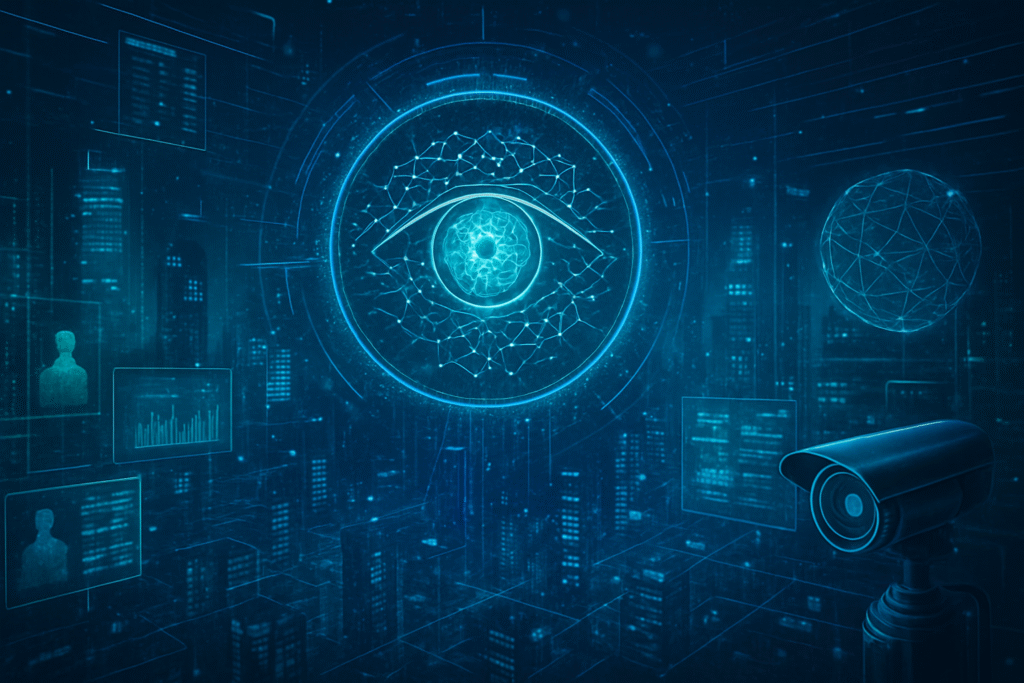
The vision of pre-emptive justice, once confined to the realm of science fiction in films like 'Minority Report,' is rapidly becoming a tangible, albeit controversial, reality with the rise of AI-powered security systems. As of October 2025, these advanced technologies are transforming surveillance, physical security, and cybersecurity, moving from reactive incident response to proactive threat prediction and prevention. This paradigm shift promises unprecedented levels of safety and efficiency but simultaneously ignites fervent debates about privacy, algorithmic bias, and the very fabric of civil liberties.
The integration of artificial intelligence into security infrastructure marks a profound evolution, equipping systems with the ability to analyze vast data streams, detect anomalies, and automate responses with a speed and scale unimaginable just a decade ago. While current AI doesn't possess the infallible precognition of 'Minority Report's' "precogs," its sophisticated pattern-matching and predictive analytics capabilities are pushing the boundaries of what's possible in crime prevention, forcing society to confront the ethical and regulatory complexities of a perpetually monitored world.
Unpacking the Technical Revolution: From Reactive to Predictive Defense
The core of modern AI-powered security lies in its sophisticated algorithms, specialized hardware, and intelligent software, which collectively enable a fundamental departure from traditional security paradigms. As of October 2025, the advancements are staggering.
Deep Learning (DL) models, such as Convolutional Neural Networks (CNNs) and Recurrent Neural Networks (RNNs) like Long Short-Term Memory (LSTM), are at the forefront of video and data analysis. CNNs excel at real-time object detection—identifying suspicious items, weapons, or specific vehicles in surveillance feeds—while LSTMs analyze sequential patterns, crucial for behavioral anomaly detection and identifying complex, multi-stage cyberattacks. Reinforcement Learning (RL) techniques, including Deep Q-Networks (DQN) and Proximal Policy Optimization (PPO), are increasingly used to train autonomous security agents that can learn from experience to optimize defensive actions against malware or network intrusions. Furthermore, advanced Natural Language Processing (NLP) models, particularly BERT-based systems and Large Language Models (LLMs), are revolutionizing threat intelligence by analyzing email context for phishing attempts and automating security alert triage.
Hardware innovations are equally critical. Graphics Processing Units (GPUs) from companies like NVIDIA (NASDAQ: NVDA) remain indispensable for training vast deep learning models. Google's (NASDAQ: GOOGL) custom-built Tensor Processing Units (TPUs) provide specialized acceleration for inference. The rise of Neural Processing Units (NPUs) and custom AI chips, particularly for Edge AI, allows for real-time processing directly on devices like smart cameras, reducing latency and bandwidth, and enhancing data privacy by keeping sensitive information local. This edge computing capability is a significant differentiator, enabling immediate threat assessment without constant cloud reliance.
These technical capabilities translate into software that can perform automated threat detection and response, vulnerability management, and enhanced surveillance. AI-powered video analytics can identify loitering, unauthorized access, or even safety compliance issues (e.g., workers not wearing PPE) with high accuracy, drastically reducing false alarms compared to traditional CCTV. In cybersecurity, AI drives Security Orchestration, Automation, and Response (SOAR) and Extended Detection and Response (XDR) platforms, integrating disparate security tools to provide a holistic view of threats across endpoints, networks, and cloud services. Unlike traditional rule-based systems that are reactive to known signatures, AI security is dynamic, continuously learning, adapting to unknown threats, and offering a proactive, predictive defense.
The AI research community and industry experts, while optimistic about these advancements, acknowledge a dual-use dilemma. While AI delivers superior threat detection and automates responses, there's a significant concern that malicious actors will also weaponize AI, leading to more sophisticated and adaptive cyberattacks. This "AI vs. AI arms race" necessitates constant innovation and a focus on "responsible AI" to build guardrails against harmful misuse.
Corporate Battlegrounds: Who Benefits and Who Gets Disrupted
The burgeoning market for AI-powered security systems, projected to reach USD 9.56 billion in 2025, is a fiercely competitive arena, with tech giants, established cybersecurity firms, and innovative startups vying for dominance.
Leading the charge are tech giants leveraging their vast resources and existing customer bases. Palo Alto Networks (NASDAQ: PANW) is a prime example, having launched Cortex XSIAM 3.0 and Prisma AIRS in 2025, integrating AI-powered threat detection and autonomous security response. Their strategic acquisitions, like Protect AI, underscore a commitment to AI-native security. Microsoft (NASDAQ: MSFT) is making significant strides with its AI-native cloud security investments and the integration of its Security Copilot assistant across Azure services, combining generative AI with incident response workflows. Cisco (NASDAQ: CSCO) has bolstered its real-time analytics capabilities with the acquisition of Splunk and launched an open-source AI-native security assistant, focusing on securing AI infrastructure itself. CrowdStrike (NASDAQ: CRWD) is deepening its expertise in "agentic AI" security features, orchestrating AI agents across its Falcon Platform and acquiring companies like Onum and Pangea to enhance its AI SOC platform. Other major players include IBM (NYSE: IBM), Fortinet (NASDAQ: FTNT), SentinelOne (NYSE: S), and Darktrace (LSE: DARK), all embedding AI deeply into their integrated security offerings.
The startup landscape is equally vibrant, bringing specialized innovations to the market. ReliaQuest (private), with its GreyMatter platform, has emerged as a global leader in AI-powered cybersecurity, securing significant funding in 2025. Cyera (private) offers an AI-native platform for data security posture management, while Abnormal Security (private) uses behavioral AI to prevent social engineering attacks. New entrants like Mindgard (private) specialize in securing AI models themselves, offering automated red teaming and adversarial attack defense. Nebulock (private) and Vastav AI (by Zero Defend Security, private) are focusing on autonomous threat hunting and deepfake detection, respectively. These startups often fill niches that tech giants may not fully address, or they develop groundbreaking technologies that eventually become acquisition targets.
The competitive implications are profound. Traditional security vendors relying on static rules and signature databases face significant disruption, as their products are increasingly rendered obsolete by sophisticated, AI-driven cyberattacks. The market is shifting towards comprehensive, AI-native platforms that can automate security operations, reduce alert fatigue, and provide end-to-end threat management. Companies that successfully integrate "agentic AI"—systems capable of autonomous decision-making and multi-step workflows—are gaining a significant competitive edge. This shift also creates a new segment for AI-specific security solutions designed to protect AI models from emerging threats like prompt injection and data poisoning. The rapid adoption of AI is forcing all players to continually adapt their AI capabilities to keep pace with an AI-augmented threat landscape.
The Wider Significance: A Society Under the Algorithmic Gaze
The widespread adoption of AI-powered security systems fits into the broader AI landscape as a critical trend reflecting the technology's move from theoretical application to practical, often societal, implementation. This development parallels other significant AI milestones, such as the breakthroughs in large language models and generative AI, which similarly sparked both excitement and profound ethical concerns.
The impacts are multifaceted. On the one hand, AI security promises enhanced public safety, more efficient resource allocation for law enforcement, and unprecedented protection against cyber threats. The ability to predict and prevent incidents, whether physical or digital, before they escalate is a game-changer. AI can detect subtle patterns indicative of a developing threat, potentially averting tragedies or major data breaches.
However, the potential concerns are substantial and echo the dystopian warnings of 'Minority Report.' The pervasive nature of AI surveillance, including advanced facial recognition and behavioral analytics, raises profound privacy concerns. The constant collection and analysis of personal data, from public records to social media activity and IoT device data, can lead to a society of continuous monitoring, eroding individual privacy rights and fostering a "chilling effect" on personal freedoms.
Algorithmic bias is another critical issue. AI systems are trained on historical data, which often reflects existing societal and policing biases. This can lead to algorithms disproportionately targeting marginalized communities, creating a feedback loop of increased surveillance and enforcement in specific neighborhoods, rather than preventing crime equitably. The "black box" nature of many AI algorithms further exacerbates this, making it difficult to understand how predictions are generated or decisions are made, undermining public trust and accountability. The risk of false positives – incorrectly identifying someone as a threat – carries severe consequences for individuals, potentially leading to unwarranted scrutiny or accusations, directly challenging principles of due process and civil liberties.
Comparisons to previous AI milestones reveal a consistent pattern: technological leaps are often accompanied by a scramble to understand and mitigate their societal implications. Just as the rise of social media brought unforeseen challenges in misinformation and data privacy, the proliferation of AI security systems demands a proactive approach to regulation and ethical guidelines to ensure these powerful tools serve humanity without compromising fundamental rights.
The Horizon: Autonomous Defense and Ethical Crossroads
The future of AI-powered security systems, spanning the next 5-10 years, promises even more sophisticated capabilities, alongside an intensifying need to address complex ethical and regulatory challenges.
In the near term (2025-2028), we can expect continued advancements in real-time threat detection and response, with AI becoming even more adept at identifying and mitigating sophisticated attacks, including those leveraging generative AI. Predictive analytics will become more pervasive, allowing organizations to anticipate and prevent threats by analyzing vast datasets and historical patterns. Automation of routine security tasks, such as log analysis and vulnerability scanning, will free up human teams for more strategic work. The integration of AI with existing security infrastructures, from surveillance cameras to access controls, will create more unified and intelligent security ecosystems.
Looking further ahead (2028-2035), experts predict the emergence of truly autonomous defense systems capable of detecting, isolating, and remediating threats without human intervention. The concept of "self-healing networks," where AI automatically identifies and patches vulnerabilities, could become a reality, making systems far more resilient to cyberattacks. We may see autonomous drone mesh surveillance systems monitoring vast areas, adapting to risk levels in real time. AI cameras will evolve beyond reactive responses to actively predict threats based on behavioral modeling and environmental factors. The "Internet of Agents," a distributed network of autonomous AI agents, is envisioned to underpin various industries, from supply chain to critical infrastructure, by 2035.
However, these advancements are not without significant challenges. Technically, AI systems demand high-quality, unbiased data, and their integration with legacy systems remains complex. The "black box" nature of some AI decisions continues to be a reliability and trust issue. More critically, the "AI vs. AI arms race" means that cybercriminals will leverage AI to create more sophisticated attacks, including deepfakes for misinformation and financial fraud, creating an ongoing technical battle. Ethically, privacy concerns surrounding mass surveillance, the potential for algorithmic bias leading to discrimination, and the misuse of collected data demand robust oversight. Regulatory frameworks are struggling to keep pace with AI's rapid evolution, leading to a fragmented legal landscape and a critical need for global cooperation on ethical guidelines, transparency, and accountability.
Experts predict that AI will become an indispensable tool for defense, complementing human professionals rather than replacing them. However, they also foresee a surge in AI-driven attacks and a reprioritization of data integrity and model monitoring. Increased regulatory scrutiny, especially concerning data privacy, bias, and ethical use, is expected globally. The market for AI in security is projected to grow significantly, reaching USD 119.52 billion by 2030, underscoring its critical role in the future.
The Algorithmic Future: A Call for Vigilance
The rise of AI-powered security systems represents a pivotal moment in AI history, marking a profound shift towards a more proactive and intelligent defense against threats. From advanced video analytics and predictive policing to autonomous cyber defense, AI is reshaping how we conceive of and implement security. The comparison to 'Minority Report' is apt not just for the technological parallels but also for the urgent ethical questions it forces us to confront: how do we balance security with civil liberties, efficiency with equity, and prediction with due process?
The key takeaways are clear: AI is no longer a futuristic concept but a present reality in security. Its technical capabilities are rapidly advancing, offering unprecedented advantages in threat detection and response. This creates significant opportunities for AI companies and tech giants while disrupting traditional security markets. However, the wider societal implications, particularly concerning privacy, algorithmic bias, and the potential for mass surveillance, demand immediate and sustained attention.
In the coming weeks and months, watch for accelerating adoption of AI-native security platforms, increased investment in AI-specific security solutions to protect AI models themselves, and intensified debates surrounding AI regulation. The challenge lies in harnessing the immense power of AI for good, ensuring that its deployment is guided by strong ethical principles, robust regulatory frameworks, and continuous human oversight. The future of security is undeniably AI-driven, but its ultimate impact on society will depend on the choices we make today.
This content is intended for informational purposes only and represents analysis of current AI developments.
TokenRing AI delivers enterprise-grade solutions for multi-agent AI workflow orchestration, AI-powered development tools, and seamless remote collaboration platforms.
For more information, visit https://www.tokenring.ai/.





